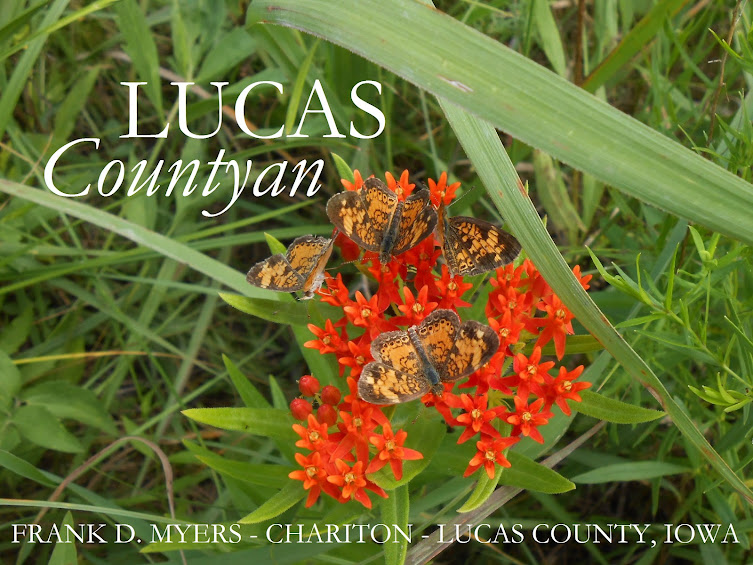Andrew Jackson "Andy" Gwinn, 1849-1926, was a story-teller who found a soulmate of sorts in Henry Gittinger, another teller of tales who also edited and published The Chariton Leader early in the 20th Century.
The result, from 1911 until approximately 1921, was a series of relatively short letters to the Leader editor that are an interesting mix of opinion, down-home philosophizing and history. Henry occasionally referred to Andy as "the sage of White Breast," referring to White Breast Creek, located near the Gwinn home in western Lucas County's Liberty Township.
The family's home base actually was in northwest Wayne County's Richman Township, named after A.J.'s uncle and aunt, Marshall H. and Mary Jane (Gwinn) Richman, and the Gwinn family cemetery is located there on what reportedly was the home farm of his parents, Samuel K. and Cynthia Gwinn. That's where A.J. was buried when he died during 1926. You'll find more about that cemetery here in a post entitled "A Thursday Morning With the Gwinns."
Here's one of Andy's early letters, published in The Leader of Sept. 21, 1911. I'm a little puzzled by some of his references. What, for example, is "the United States place"? "Chubby" referred to the type of sod, stick and mud chimney added to cabins of that time in areas where fieldstone was scarce and brick unobtainable. But I found the letter interesting, despite the puzzles:
+++
I first saw the light of day in Wapello county, Iowa, 6 miles above Ottumwa, on the 6th day of July, 1849. When about one year old, my father and mother left there and moved to Wayne county on the head waters of the (South) Chariton or Horse Shoe river. There, on the bank of that creek they built him and Mr. Richman two log cabins. I will describe them for the benefit of some of the boys and girls of today.
You get 12 or 14 logs for each side 16 feet long, as most of the cabins were built 15 feet in the clear, allow an extra foot for notching, then a man at each corner for notching or locking the corners and raising the house. These men used nothing but an ax, and I have seen them up the corners with perfectly fitting joints as any carpenter can make at this date. Then they place two logs on the United States place, one near each end and one in the middle for the floor to rest on, which consists of split logs hewn smooth on one side, edged, one end beveled to two inches, laid flat side up, keyed and called a puncheon floor on which I've danced till my toes were sore.
This sounds like poetry. Darn poetry. I am dealing with rough facts.
Let's build a chubby to this house after we cover it (the roof) with clap-boards split from the body of a tree and shaven smooth.
Cut a hole in a side 6 or 7 feet long and 4 feet high. Take a breaking plow, hitch Tom and Jerry to it. Break some prairie sod, cut the sod in squares build up to the top of your hole in the wall, then take sticks and mud, the common sort. Then finish out chubby to near the top not too high for you want to smoke your meat down inside and you are building a smoke house as well as a bungalow.
You daub the cracks full of mud, make some kind of a door and move in. When you want daylight, take a board up in the floor. You may laugh but some of the most illustrious men and women were raised in just such cabins.
A.J. Gwinn




1 comment:
Frank - I am curious if you have a good reference for Andrew Gwinn's middle name, Jackson? There has always been an assumption by most, including myself, that it was Jackson, but I've never been able to find a citable reference. Then I found his son, Everett Andrew Gwinn's, application for a social security number and he shows his father as Andrew James Gwinn. The correct mother tells me this is the correct Andrew (there are several "Andrews" in our family history, including my grandson!)
Great article, by the way.
Thanks,
Ray Gwinn Jr.
Post a Comment